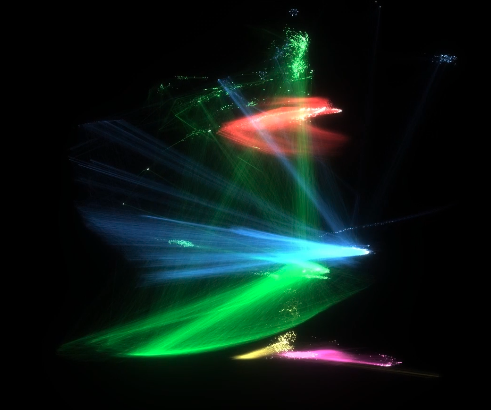Experiential Sculpting
A multimedia installation integrating empirical research knowledge and choreographic compositional practices. Empirical research knowledge forms the foundation upon which the digital choreography leans on, and is thematically inspired by. The work is one staging post in the ongoing continuum of artistic research inquiry on methods of Digital Choreography.
Experiential Sculpting
Experiential Sculpting is the first artistic component of my doctoral research on “Choreographing Emergent Corporealities in Interactive, Mediated Performance Environments”. The multimedia installation attempts to re-organise the critical findings of a study examining the audience experience of a movement-based virtual reality artwork (see post VR Ethnography). By reorganizing and exhibiting empirical research knowledge, this installation explores extending choreography into the distribution of research outcomes, and how an artistic practice queers the reading of the data and, therefore may allow a generation of deeper understanding of the research topic. The guiding question of the working process has been: How does the experience of the ’other’ inform digital choreography?
Artistis Team:
Conceptual design and research: Hanna Pajala-Assefa
Visual Design : Tomi Paijo
Sound Design: Jaakko Autio
Empirical knowledge as material
The installation visualises the findings of an inquiry studying audience experience of VR art.
The juxtaposed visualisations are set to convey the modes of thinking, perceiving, and the epistemic agency, which are at stake when the living body is in expressive contact with interactive technology. One of the main results from the audience study was the recognition of two modes of engagement, which the viewer adopts and continuously shifts in, during their engagement with the artwork's choreographic system in virtual reality. These modes were:
1. a cognitive-instrumental approach. Where the user focuses on understanding and obtaining the properties of the user interface. That is, using the digital system as an instrument for creation.
2. an embodied-aesthetic approach. A mode of open-ended engagement with the material and affective qualities of oneself and the artwork's aesthetic materials. In this mode, one engages in a creative process of moving within the system and perceiving the resulting audiovisual material without a conscious aim, hence following the affective qualities of the aesthetic events at hand.
The concept of the installation was to visualise these study results and to exhibit them in an artistic format.
The Artwork
The installation is a performatively layered media art installation, a constellation of moving images on 8 screens and an interactive soundscape.
As visitors step into the immersive world of this multimedia installation, they are greeted by a fusion of visual and auditory elements. The independently arranged audio and visual components perform their gestures, yet perceptually they merge, creating a soft and inviting interpretive space. Audio and visual agents transmit sensory impulses, performing both as singular and plural, actuating potential transfer in our focal attention from events of a single display to the relative interpretive betweenness of the elements. The circular spatial constellation of the 8 video screens with performative figures allows relationality according to the viewers’ bodily orientation. The audience is invited to self-organize, attend to bodily perception, and let the potential interpretations unfold in conjunction with all elements. Hence, suggested to engage and encounter this digital exhibition corporeally and let the body shimmer through the layers of digital matter.
The Synergy of Empirical Research and Choreographic Composition
The movement data digitally visualized in the artwork was collected during an audience study conducted in June 2022. There, I examined the qualities and nature of experiencing a virtual, movement-based, open-ended VR artwork Skeleton Conductor XR Art, where the viewer is conducting the audio-visual virtual environment through their gestures and movements while immersed in a digital space. This agential frame of the SC artwork places the viewer in the position of performer; they are the perceiver and actuator in the spatiotemporal event of the artwork. Through the phenomenological approach of analysing their experience, I aimed to further understand what is at stake when the body is in contact with a lived and enacted digital environment. This embodied analysis process also informed the extended choreographic practice.
The Experiential Sculpting artwork, which remediates the knowledge gathered from the study, was constructed through a choreographic process. The somatic bodily processing and choreographic composition were methods to transpose, translate, and transmediate qualities of the viewers’ bodily experience into a new medium, a media art installation, to be re-interpreted by the audience. The digitally processed moving images, designed collaboratively with visual artist Tomi Paijo are derived from the mocap data collected from the case study, and the situated interactive sound designed by Jaakko Autio, are all outcomes of a process of digital choreographic composition and data analysis.
